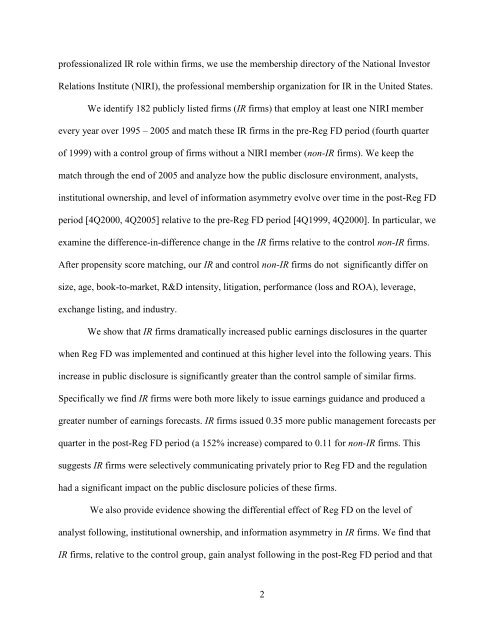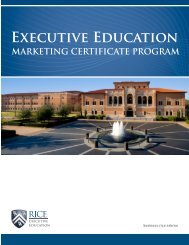Investor Relations and Regulation FD
Investor Relations and Regulation FD
Investor Relations and Regulation FD
Create successful ePaper yourself
Turn your PDF publications into a flip-book with our unique Google optimized e-Paper software.
professionalized IR role within firms, we use the membership directory of the National <strong>Investor</strong><br />
<strong>Relations</strong> Institute (NIRI), the professional membership organization for IR in the United States.<br />
We identify 182 publicly listed firms (IR firms) that employ at least one NIRI member<br />
every year over 1995 – 2005 <strong>and</strong> match these IR firms in the pre-Reg <strong>FD</strong> period (fourth quarter<br />
of 1999) with a control group of firms without a NIRI member (non-IR firms). We keep the<br />
match through the end of 2005 <strong>and</strong> analyze how the public disclosure environment, analysts,<br />
institutional ownership, <strong>and</strong> level of information asymmetry evolve over time in the post-Reg <strong>FD</strong><br />
period [4Q2000, 4Q2005] relative to the pre-Reg <strong>FD</strong> period [4Q1999, 4Q2000]. In particular, we<br />
examine the difference-in-difference change in the IR firms relative to the control non-IR firms.<br />
After propensity score matching, our IR <strong>and</strong> control non-IR firms do not significantly differ on<br />
size, age, book-to-market, R&D intensity, litigation, performance (loss <strong>and</strong> ROA), leverage,<br />
exchange listing, <strong>and</strong> industry.<br />
We show that IR firms dramatically increased public earnings disclosures in the quarter<br />
when Reg <strong>FD</strong> was implemented <strong>and</strong> continued at this higher level into the following years. This<br />
increase in public disclosure is significantly greater than the control sample of similar firms.<br />
Specifically we find IR firms were both more likely to issue earnings guidance <strong>and</strong> produced a<br />
greater number of earnings forecasts. IR firms issued 0.35 more public management forecasts per<br />
quarter in the post-Reg <strong>FD</strong> period (a 152% increase) compared to 0.11 for non-IR firms. This<br />
suggests IR firms were selectively communicating privately prior to Reg <strong>FD</strong> <strong>and</strong> the regulation<br />
had a significant impact on the public disclosure policies of these firms.<br />
We also provide evidence showing the differential effect of Reg <strong>FD</strong> on the level of<br />
analyst following, institutional ownership, <strong>and</strong> information asymmetry in IR firms. We find that<br />
IR firms, relative to the control group, gain analyst following in the post-Reg <strong>FD</strong> period <strong>and</strong> that<br />
2
















